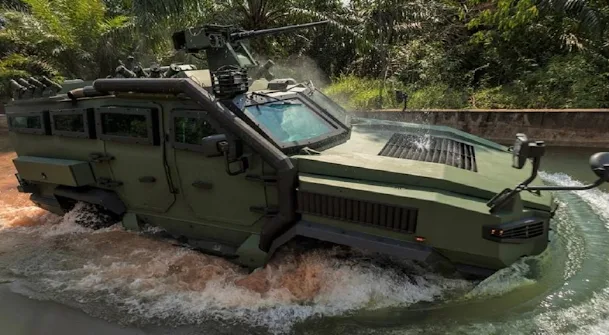 |
| HMAV Tarantula Combat Vehicle Expected to Strengthen the Malaysian Army |
Kuala Lumpur - The Tarantula armored high mobility 4x4 fighting vehicle (HMAV) is being developed by Malaysia. The Tarantula HMAV 4X4 military tactical vehicle is a collaboration between the Malaysian Ministry of Defense and local company Milfef International Technology.
It was announced that the Malaysian Ministry of Defense will procure 136 units of Type A 4x4 vehicles and various units of Type B Vehicles. Apart from a brief announcement, not many details were given regarding the procurement of 136 units of Type A 4×4 Vehicles and Type B Vehicles.
However, budget allocation is provided for the procurement of both types of vehicles which are closely related to the Condor and Sibmas armored vehicle replacement programs.
Quoted from Defense Security Asia, an industry source revealed that the acquisition of 136 4×4 vehicles will likely involve the Tarantula High Mobility Armored Vehicle (HMAV). Procurement negotiations are ongoing to replace the Malaysian Army's long-standing 4x4 Condor armored vehicle.
A total of 136 4×4 vehicles will complete two regiments, 3 Armor and 4 Armor, according to industry sources involved. All 136 4×4 vehicles consist of three to four variants such as Armored Personnel Carrier (APC), Armored Combat Vehicle (ACV), Armored Recovery Vehicle (ARV) and ambulance.
Regarding the Tarantula platform weapon, it depends on the variant and the customer's wishes. This armored vehicle made by a local company can be equipped with a 12.7mm Remote Control Weapon System (RCWS), Anti-Tank Guided Weapon (ATGW), Multiple Grenade Launcher (MGL) and others according to customer requirements.
 |
| High mobility armored 4x4 fighting vehicle (HMAV) Tarantula |
Tarantula is built on a modular platform with various specifications from the most basic to the most advanced to facilitate any modification and meet the specifications of any country wishing to use the application.
The armored vehicle is equipped with a Stanag 4569 Level 2B undercarriage and a Stanag 4569 Level 2 body armor to protect the crew inside the vehicle. The power-to-weight ratio for the MILDEF HMAV 4x4 is 24 horsepower/ton. This provides ample ground clearance for this vehicle to pass through various obstacles with ease.
Apart from the HMAV Tarantula, MILDEF also developed the Rentaka which was only revealed to the public at the DSA exhibition a few months ago, but the Rentaka vehicle is more for domestic security tasks.
Speaking at the Tarantula naming ceremony in April 2020, then Defense Minister Datuk Seri Ismail Sabri Yaakob said the armored car had undergone various tests by the Malaysian Army (TDM) and the Ministry of Defense Science and Technology Research Institute (STRIDE).
"For the nine-day on-road test, it includes a 700-kilometre (km) trip and a 300-km 'off-road' guide test," he said, now the Prime Minister of Malaysia. Ismail Sabri said what MILDEF has highlighted has proven that local talent and companies are also capable of producing defense vehicles of the same quality as those produced abroad, even better.
Quoted from Army Technology, this combat vehicle Tarantula made by Mildef was designed according to UN standards and specifications. Because Tarantula combat vehicle is intended for domestic and international markets. In addition, Mildef with a manufacturing team of 140 local experts including eight engineers can manufacture up to 40 armored vehicles every year.
Not long ago, around March 2021, it was discovered that the Malaysian Army, STRIDE, and Mildef had completed the first round of evaluation tests of the Ranpur Tarantula.
The Tarantula combat vehicle test is said to have involved 700 km of road testing and 300 km of off-road testing. And the results shown by Ranpur Tarantula concluded if the vehicle's road resistance, installation and descent, fuel efficiency, load, winching, slope, climb and braking ability.
